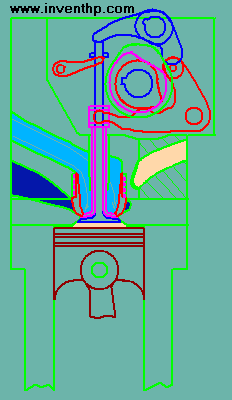Biogas Engine
Biogas is formed in anaerobic digesters where
microscopic organisms in
the absence of air act on starches and other organic compounds to
produce methane and carbon dioxide (approximate molar analysis
60% CH4, 30% CO2, 10% N2). See the following link => Micro-Scale Biogas Production: A Beginners Guide if you want to know more about this process.
The
proposed engine burning biogas will mechanically
be
much like the "Dual Pressure Intake Engine". The below diagram and
animation describe the operation of this 'Green' engine.

|
Biogas Engine
(With
Low Pressure Direct Induction Fuel System)
In
the animation above:
Light
blue = air intake (at 1 atm)
and
Navy blue
= biogas or producer gas
(storage
pressure ~ 4 - 10 atm)
Using
an induction system
similar to the "Dual
Pressure Intake
Engine" but with the fuel and air in separate intake runners, one can
boost the
volumetric efficiency of an engine running on biogas that is 50 percent methane
by about 20%. This engine would
not require a
supercharger or turbocharger since the boost would be provided by the
storage pressure of the fuel.
This would be accomplished by
first filling the cylinder with
ambient
pressure
air and then allowing the biogas to top the cylinder to a boosted pressure. The amount of boost would be limited by the stoichiometric balance of the fuel. Boosting volumetric
efficiency by taking advantage of the pressurized fuel is important
since
biogas has a low heat content
compared to Natural Gas, for example.
Also, the
kinetic energy of the fuel/air mix will be high due to the large
pressure
differential between the induced air (~ 1 atm) and the fuel's storage
pressure
(4-10 atm). This should help the charge burn quicker and more
efficiently.
|